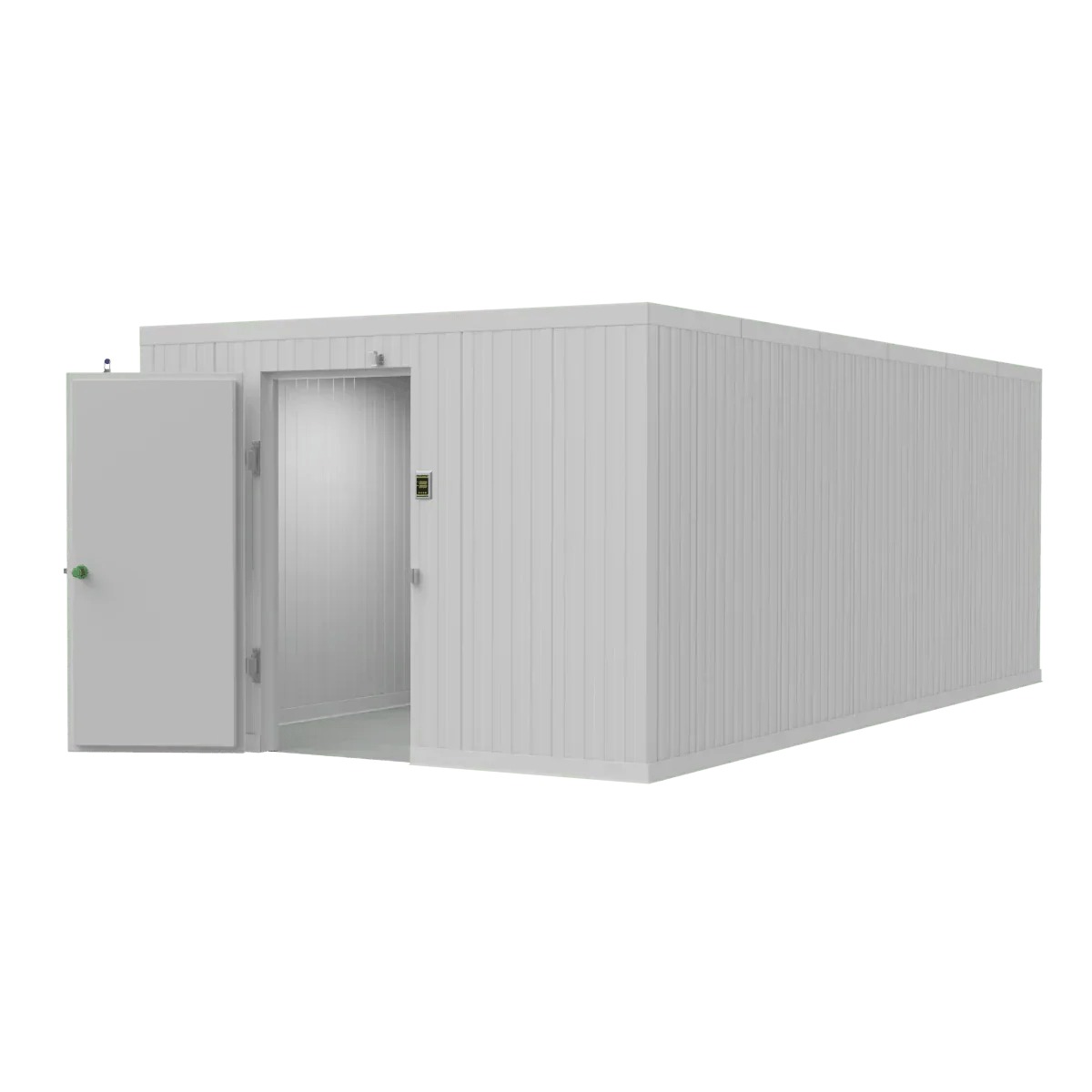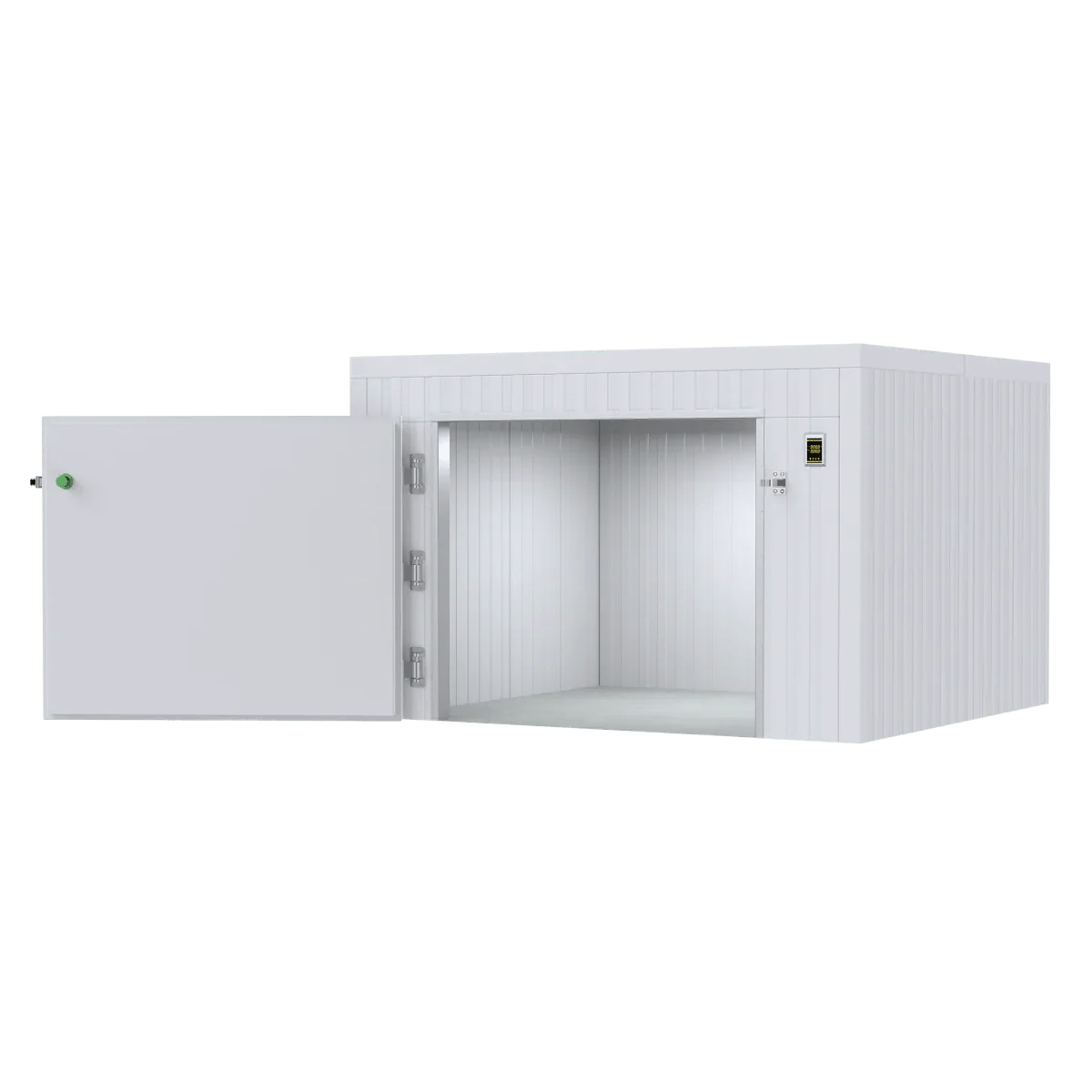Why Choosing the Right EMS-Stretcher Can Save Lives and Prevent Injuries
An EMS-stretcher is a specialized patient transport device designed for emergency medical services, featuring adjustable height mechanisms, safety restraints, and mobility systems that enable safe patient transport from accident scenes to medical facilities. Modern EMS stretchers serve multiple critical functions beyond basic transport - they provide stable platforms for medical interventions, minimize patient movement to prevent secondary injuries, and reduce physical strain on emergency responders.
Key EMS-Stretcher Types and Applications:
- Manual Stretchers - Basic wheeled units requiring manual lifting (350-400 lbs capacity)
- Powered Stretchers - Electric/hydraulic lift systems (up to 700 lbs capacity)
- Rescue Scoop Stretchers - Split-frame design reduces secondary injuries by 30%
- Spine Boards - Rigid immobilization for spinal trauma cases
- Basket Stretchers - Protective shells for rough terrain rescue
- Bariatric Stretchers - Heavy-duty units for high-BMI patients (500-700 lbs)
- Stair Chairs - Compact evacuation from multi-story buildings
The research shows that over 60% of emergency response teams in major cities now prefer Rescue Scoop Stretchers due to their unique safety benefits, while powered stretchers like the Ferno Power X2 can lift up to 350 kg, significantly reducing EMS personnel injury risk.
As American Mortuary Coolers, we've spent years working with funeral directors and emergency service providers to understand the critical importance of reliable patient transport equipment, including EMS-stretcher systems that must perform flawlessly in high-stress situations. Our experience has shown that choosing the right stretcher can make the difference between smooth operations and costly equipment failures that compromise both patient care and staff safety.
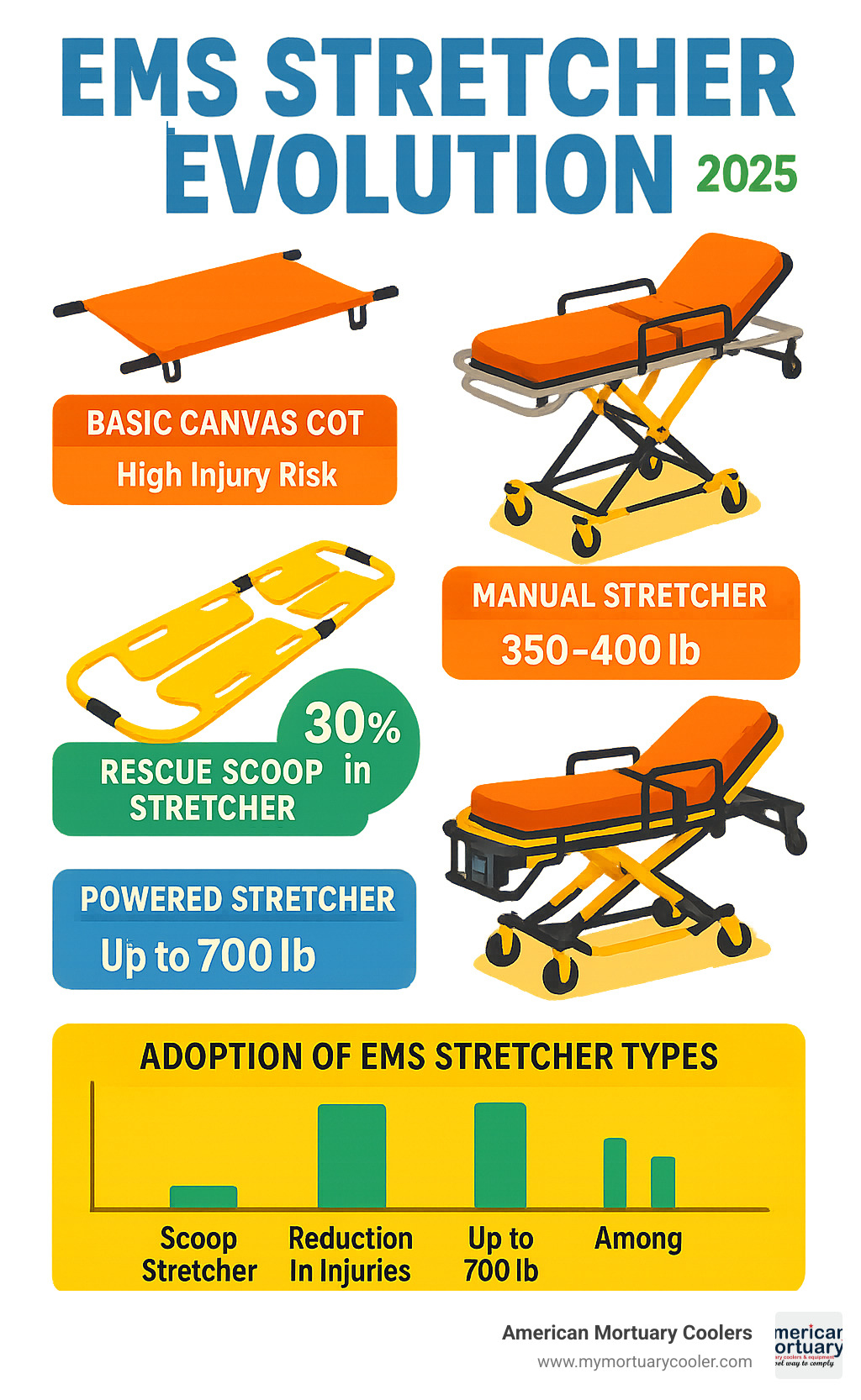
Ems-stretcher glossary:
What Is an EMS-Stretcher and Why It's Mission-Critical
Think of an EMS-stretcher as the unsung hero of emergency medical care. It's far more than just a wheeled bed - it's a sophisticated piece of equipment that literally carries the weight of life-and-death situations on its frame.
At its core, an EMS-stretcher is a specialized patient transport device built to handle the chaos and urgency of emergency medical services. These aren't your typical hospital gurneys. They're engineered tough, designed to roll smoothly from accident scenes to ambulance floors to emergency room doors, all while keeping patients safe and comfortable.
Modern stretchers are impressive workhorses. Most handle between 350 to 700 pounds, but some specialized models go even further. Take the Ferno Harrier electric ambulance stretcher - it's the only powered ambulance trolley in the UK that can lift up to 350 kg (that's 770 pounds!). That's serious lifting power when you need it most.
But here's what really matters: these stretchers must fit perfectly into ambulance systems. The stretcher needs to lock securely into the ambulance while still giving paramedics room to work around the patient during those critical transport moments.
Regulatory standards keep everything safe and consistent. These rules ensure every stretcher meets strict requirements for things like locking mechanisms, adjustable height ranges, and compatibility with vehicle fastening systems.
Core Functions of an EMS-Stretcher
An EMS-stretcher wears many hats during an emergency call. Its most important job is stabilization - keeping patients secure and preventing any movement that could make injuries worse. The sturdy frame and restraint systems work together like a protective cocoon.
Rapid transport is where these stretchers really shine. The wheels aren't just afterthoughts - they're carefully designed to roll smoothly across hospital floors, parking lots, and even rough outdoor terrain. EMTs and paramedics need to move fast, and the stretcher has to keep up without losing control or stability.
But perhaps the most critical function is serving as a mobile treatment platform. During transport, medical teams are often fighting to save lives. They need to start IVs, monitor vital signs, and perform procedures - all while the ambulance is moving. The stretcher becomes their workspace, holding IV poles and equipment while providing a stable surface for life-saving interventions.
How Modern Design Minimises Secondary Injury
Here's something that might surprise you: sometimes the biggest danger to a patient isn't their original injury - it's what happens during transport. That's why modern EMS-stretcher design focuses heavily on preventing secondary injuries.
Frame geometry isn't just engineering jargon - it's about patient safety. X-frame and H-frame designs each offer different benefits for stability and maneuverability.
Shock absorption systems have become game-changers. These systems use advanced materials and smart engineering to protect patients from jarring movements. Whether it's rolling over rough pavement or dealing with ambulance vibrations, these systems act like a buffer between the patient and the bumpy real world.
Modern restraint systems are light-years ahead of old-fashioned straps. Today's versions feature color-coded straps that make it easy to secure patients quickly and correctly. The quick-release mechanisms mean medical teams can access patients fast when needed, while the improved design distributes pressure evenly across the body.
Comparing the Main Types of EMS Stretchers
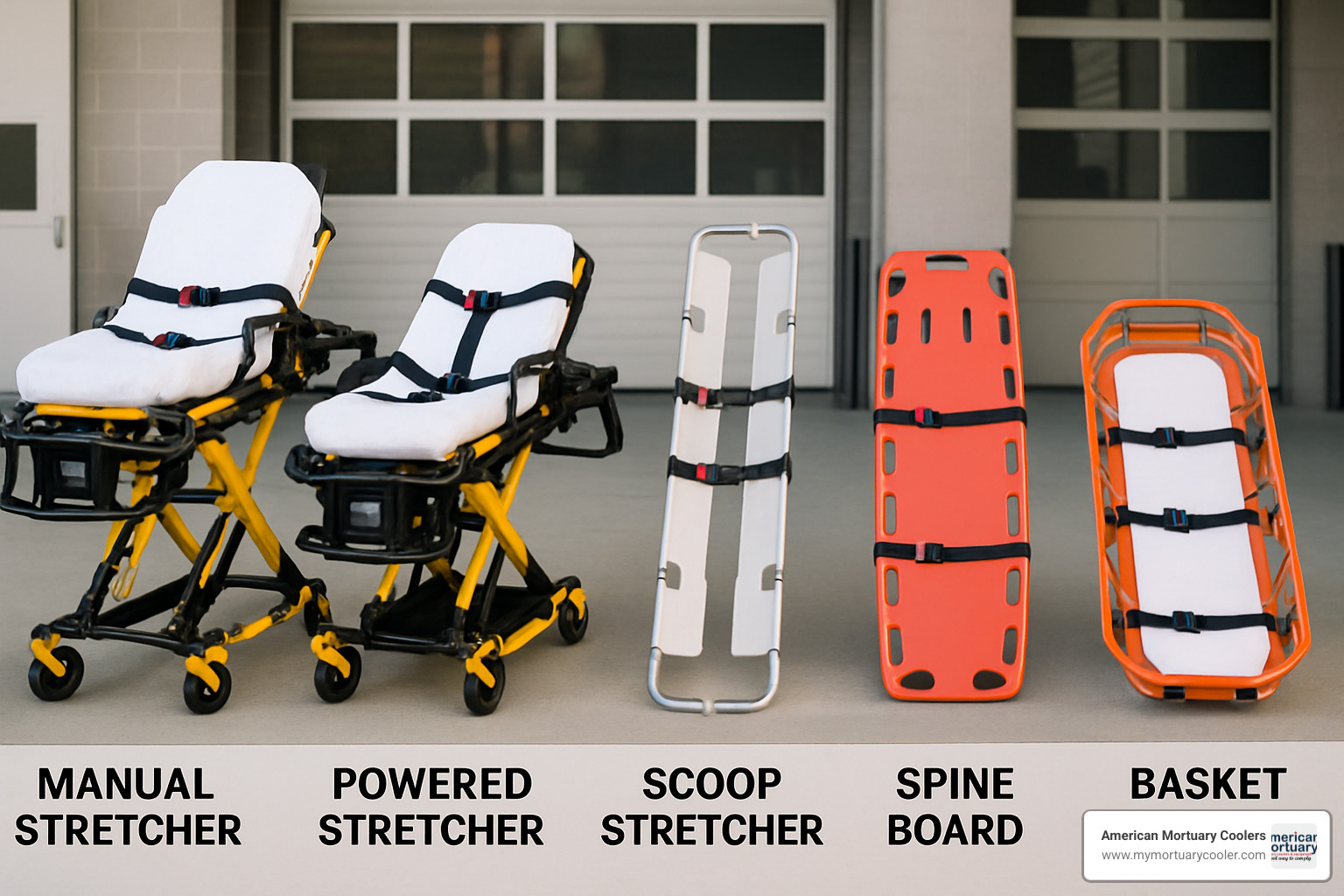
Walking into any EMS station today, you'll find a variety of stretchers that might seem overwhelming at first glance. But each EMS-stretcher type exists for good reason - they're designed to handle specific situations that emergency responders face every day.
Manual stretchers still form the backbone of many emergency services. These reliable workhorses handle 350-400 pound weight limits and don't need batteries or complex maintenance. They're simple, dependable, and cost-effective - perfect for services with tight budgets or rural areas where simplicity matters most.
Powered stretchers have revolutionized patient transport by taking the physical strain off EMT personnel. Modern units like the Stryker Power-PRO XT and Ferno Power X2 use electric or hydraulic systems to do the heavy lifting. This isn't just about convenience - it's about preventing the back injuries that plague emergency responders.
| Stretcher Type | Weight Capacity | Primary Use Case | Cost Range |
|---|---|---|---|
| Manual | 350-400 lbs | Basic transport, budget-conscious services | $800-$2,500 |
| Powered | 500-700 lbs | Reducing EMT injury risk, bariatric patients | $8,000-$15,000 |
| Scoop | 350-500 lbs | Trauma scenes, spinal injuries | $1,200-$3,000 |
| Spine Board | 300-400 lbs | Spinal immobilization | $150-$400 |
| Basket | 300-600 lbs | Rough terrain, helicopter transport | $800-$2,500 |
| Stair Chair | 350-500 lbs | Multi-story evacuations | $1,500-$4,000 |
Rescue Scoop vs. Traditional Ambulance Stretchers
The rescue scoop stretcher represents one of those "why didn't we think of this sooner?" innovations. Its split-frame design allows the stretcher to separate into two halves, letting EMTs slide each piece under the patient from opposite sides. No more rolling or lifting injured patients - something that makes perfect sense when you think about it.
Scientific research on Rescue Scoop Stretchers shows impressive results. The data reveals a 30% reduction in secondary injuries compared to traditional stretchers. That's not just a statistic - it represents real people who avoided additional harm during their most vulnerable moments.
The time savings are equally compelling. A 2021 study found approximately 20% reduction in patient handling time compared to conventional methods. In emergency medicine, those saved minutes can literally mean the difference between life and death.
What really sets scoop stretchers apart is their lightweight construction. Made from high-strength aluminum or composite materials, they're easier to maneuver in tight spaces while maintaining the structural integrity needed for safe patient transport.
Spine Boards & Basket Stretchers in Rugged Terrain
Spine boards might not win any comfort awards, but they serve a critical purpose that can't be compromised. When someone has a suspected spinal injury, these rigid platforms provide complete immobilization. Yes, they're uncomfortable for patients, but preventing catastrophic secondary injuries to the spinal cord makes this temporary discomfort absolutely necessary.
Basket stretchers shine in situations where regular wheeled stretchers simply can't go. Their protective shell design creates a cocoon around the patient, shielding them from rocks, branches, or debris during transport over rough terrain. Mountain rescue teams and disaster response crews rely on these units when the path to safety isn't smooth or predictable.
When to Deploy Bariatric & Stair Solutions
The reality of modern healthcare includes caring for patients of all sizes with equal dignity and safety. Bariatric stretchers address this need with heavy-duty construction that typically supports 500-700 pounds, with some models handling even more. The Ferno Powerflex cots can handle up to 700 lbs unassisted - a game-changer for both patient care and responder safety.
The powered lift mechanisms in bariatric stretchers aren't just convenient features - they're essential safety equipment. Manual lifting of heavy patients poses serious injury risks to EMS personnel's backs and joints.
Stair chairs solve one of urban emergency response's most challenging puzzles: getting patients out of multi-story buildings when elevators aren't available or safe to use. These compact units feature tracks or wheels designed specifically for stairwell navigation. Some models even offer powered assistance for controlled descent, reducing the physical strain on responders while maintaining patient safety.
Key Features, Safety Innovations & Ergonomics

When you're choosing an EMS-stretcher, the features matter more than you might think. These aren't just fancy add-ons - they're the difference between smooth operations and potential disasters when seconds count.
The adjustable height mechanism is probably the most important feature you'll use every day. Modern stretchers can match hospital bed heights perfectly, making patient transfers seamless. They also adjust to different ambulance loading heights, which saves your team's backs and reduces the risk of dropping patients during awkward transfers.
Hydraulic and powered lift systems have completely changed the game for emergency responders. The Ferno iNX Integrated System stands out as the first fully integrated patient transport and loading system, making the entire process smoother and safer.
The frame design choice between X-frame and H-frame affects daily operations more than most people realize. X-frame stretchers fold up nice and compact for storage, while H-frame designs give you rock-solid stability during transport.
Antimicrobial mattresses and surfaces aren't just nice to have anymore - they're essential for infection control. Integrated IV poles and equipment mounting points mean medical interventions can continue without interruption during transport.
Benefits & Limits of Powered vs. Manual EMS-Stretchers
The powered versus manual debate isn't just about convenience - it's about protecting your most valuable asset: your team. One EMS service reported a 40% reduction in staff injuries after switching to automated stretchers. That's not just a number on paper - that's fewer workers' comp claims, less downtime, and happier, healthier employees.
Scientific research on ergonomic lifting shows that powered systems let EMTs and paramedics focus their energy where it counts most. Instead of wrestling with heavy equipment, they can concentrate on patient assessment and care.
But let's be honest about the downsides. Battery maintenance becomes a critical part of your daily routine with powered stretchers. Dead batteries during an emergency call isn't just inconvenient - it's potentially dangerous. You'll need solid charging protocols and backup systems in place.
The cost trade-offs are significant too. Powered stretchers cost substantially more upfront, and maintenance is more complex. However, most agencies find that reduced injury claims and improved efficiency make the investment worthwhile over time.
Materials & Durability That Matter
The materials in your EMS-stretcher determine whether it'll last five years or fifteen years. Aluminum alloy frames have become the gold standard because they hit that sweet spot between strength and weight. You get the structural integrity needed for safe patient transport without the back-breaking weight of older steel models.
High-strength composites are pushing the envelope even further, offering incredible durability at even lighter weights. These advanced materials mean less operator fatigue and lower injury risk during extended operations.
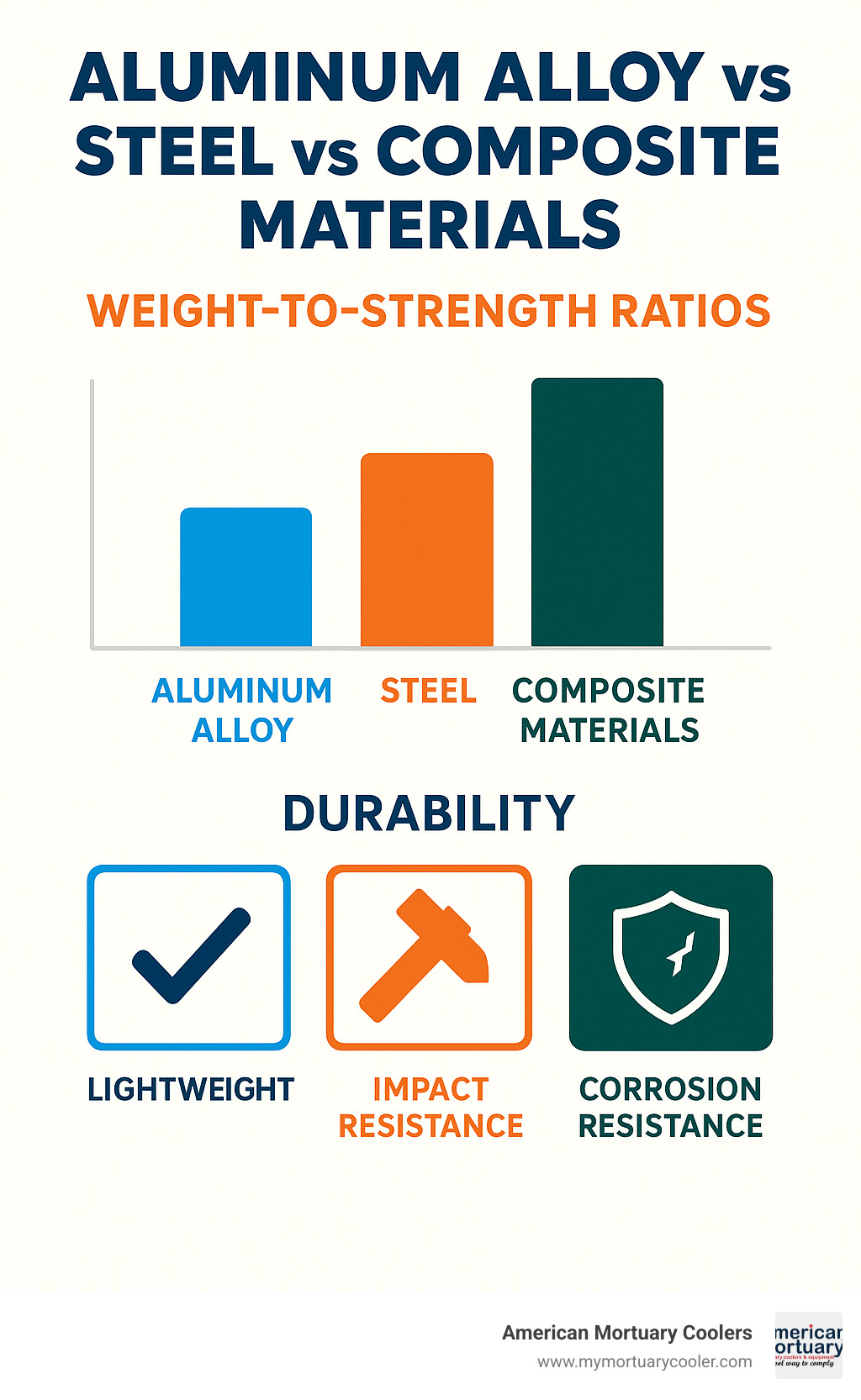
Corrosion resistance might not seem exciting, but it's crucial for equipment that gets cleaned and decontaminated multiple times daily. Easy decontamination features make everyone's life easier and safer. Look for smooth surfaces without crevices where nasty stuff can hide, removable components that can go through proper cleaning cycles, and materials that can handle aggressive cleaning agents without breaking down.
Must-Have Safety Features in 2024
Safety features in modern EMS-stretchers aren't optional extras - they're essential equipment that can prevent accidents and save lives. Auto-locking wheels prevent those heart-stopping moments when a stretcher starts rolling at the worst possible time during patient loading or medical procedures.
Color-coded straps might seem simple, but they're brilliant in practice. When you're working under pressure, visual confirmation that restraints are properly applied can prevent serious accidents.
Side-rail sensors represent the cutting edge of stretcher safety technology. These systems alert operators when rails aren't positioned correctly or when they detect unexpected patient movement.
Integrated loading guides take the guesswork out of ambulance loading, helping ensure proper alignment and secure fastening to vehicle anchor points. Other critical features include backup power systems for powered stretchers, emergency release mechanisms for restraints, and reflective materials for visibility during nighttime operations.
Choosing the Right EMS-Stretcher for Specific Scenarios
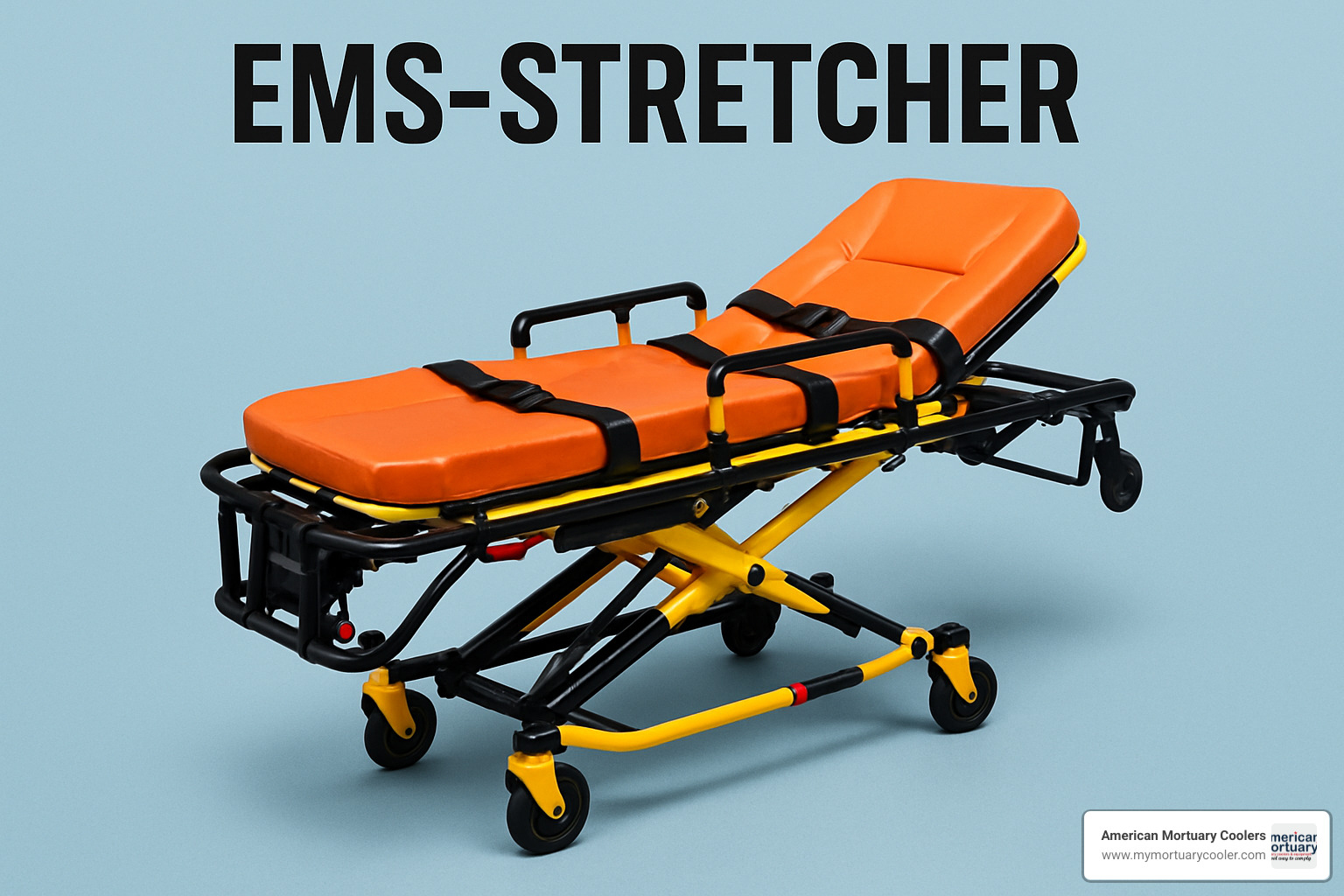
Choosing the right EMS-stretcher is like picking the perfect tool for a job - you need to match the equipment to the challenge ahead. Every emergency call presents unique circumstances, and having the wrong stretcher can turn a routine transport into a complicated ordeal.
Your environment tells the first part of the story. If you're working busy city streets with smooth sidewalks and reliable elevator access, you have different needs than a rural service covering mountain roads and farmhouses with narrow doorways. Urban teams often favor powered stretchers for their efficiency and back-saving benefits, while rural services might prioritize durability and simplicity over bells and whistles.
Patient condition shapes your equipment choice just as much as location does. A cardiac patient who needs frequent position changes requires different support than someone with a suspected spinal injury who must remain completely immobilized. Bariatric patients demand heavy-duty equipment that can handle their weight safely.
Available manpower becomes the deciding factor when your crew is stretched thin. Powered stretchers aren't just convenient - they become essential when you're running multiple calls with limited personnel.
Practical Selection Checklist for EMS Agencies
When you're evaluating EMS-stretcher options, start with an honest assessment of your operational reality. Terrain analysis should look beyond just "urban versus rural" - consider the specific challenges your teams face daily. Do you regularly steer gravel driveways, apartment building stairwells, or hospital parking garages with tight turns?
Transport vehicle compatibility often gets overlooked until delivery day when you find your new stretcher doesn't quite fit your ambulance configuration. Measure twice, buy once applies here - interior dimensions, door widths, and loading heights all matter more than you might expect.
Your bariatric patient frequency deserves careful analysis. Review your call logs from the past year to understand not just how often you encounter high-weight patients, but what weight ranges you're actually dealing with. This data helps justify investing in specialized equipment versus making do with standard capacity stretchers.
Accessory integration can make or break your investment. Your existing IV poles, monitoring equipment, and other medical devices need to work seamlessly with any new stretcher system. More info about stretcher wheel options can help you understand how different mobility solutions might affect your current workflow.
Training, Maintenance & Lifecycle Costs
The true cost of any EMS-stretcher extends far beyond the purchase price. Training requirements vary dramatically between equipment types - manual stretchers need solid instruction in proper lifting techniques and team coordination, while powered systems require additional education on controls, battery management, and basic troubleshooting.
Annual inspections keep your equipment reliable and compliant, but they also represent ongoing operational costs. Plan for systematic checks of structural integrity, wheel function, restraint systems, and for powered units, battery performance and hydraulic operation.
Cleaning protocols must balance infection control with equipment preservation. Different materials respond differently to cleaning agents, and improper procedures can damage antimicrobial coatings or degrade structural components over time.
Battery replacement cycles for powered stretchers represent a significant ongoing expense that catches many agencies off guard. Expect battery replacement every 2-3 years depending on usage patterns, with costs ranging from several hundred to several thousand dollars per cycle.
At American Mortuary Coolers, we understand that equipment decisions affect your operations for years to come. For comprehensive guidance on making the right choice for your specific needs, check out A Practical Guide to Comparing and Buying an EMT Stretcher.
Frequently Asked Questions about EMS-Stretchers
How do stretcher choices affect EMT injury risk?
The type of EMS-stretcher you choose can make or break your team's physical wellbeing. We've seen agencies transform their injury rates simply by switching equipment - and the numbers don't lie.
Manual stretchers put your EMTs at serious risk for back and joint injuries. Every lift, every awkward angle, every heavy patient adds up over time. The human body wasn't designed for the repetitive lifting that comes with traditional stretcher work, especially when you're dealing with stressed situations and tight spaces.
Here's where it gets interesting: powered stretchers can slash staff injuries by up to 40%. That's not just a small improvement - that's potentially career-saving for your team members. The powered lift mechanism eliminates the most dangerous part of patient transport: the heavy lifting.
But even with manual stretchers, smart choices matter. Look for lightweight materials and ergonomic handles that reduce strain. Always follow the two-person minimum rule, and don't hesitate to call for four people when dealing with heavier patients or tricky terrain. Your EMTs' backs will thank you later.
What are the ongoing maintenance requirements?
Let's be honest - maintenance isn't the most exciting part of owning an EMS-stretcher, but it's absolutely critical. Think of it like maintaining your ambulance: skip it, and you're asking for trouble at the worst possible moment.
Daily checks should become second nature for your team. A quick look at wheels, locks, and restraint systems takes just minutes but prevents major headaches. Any wobbling, sticking, or unusual wear needs immediate attention. This equipment literally carries lives.
Weekly maintenance gets more thorough. Deep cleaning and decontamination protect both patients and staff from infection. Don't forget to lubricate moving parts and check battery levels on powered units. It's amazing how many emergency calls get complicated by dead batteries that could have been prevented.
The monthly inspection is where you catch problems before they become emergencies. Hydraulic systems need pressure checks, electrical connections need testing, and height mechanisms need calibration. For powered stretchers, this is especially crucial since they have more complex systems that can fail.
Annual professional servicing isn't optional - it's essential. A qualified technician can spot issues that daily users might miss and ensure your equipment meets safety standards. This is particularly important for powered systems where technical problems can leave you literally stuck.
Should I buy new, powered, or refurbished equipment?
This question keeps many EMS directors up at night, and honestly, there's no one-size-fits-all answer. But we can help you think through the decision.
New equipment gives you peace of mind - latest safety features, full warranty, and the longest possible service life. If budget allows, new EMS-stretchers offer the best long-term value, especially for high-volume agencies. You're also getting equipment that meets current safety standards without question.
Powered stretchers represent a significant investment, but they pay dividends in reduced injuries and improved efficiency. If your team handles multiple calls daily or frequently deals with bariatric patients, the ergonomic benefits often justify the higher cost. Calculate potential savings from reduced worker compensation claims - the numbers might surprise you.
Refurbished equipment offers a middle ground that works well for many agencies. Quality refurbished EMS-stretchers undergo thorough inspection and repair, often including upgraded components. This option works particularly well for backup equipment or agencies with tight budgets.
Consider your total cost of ownership, not just the purchase price. A cheaper manual stretcher might cost more in the long run if it leads to staff injuries or frequent repairs. Factor in training costs, maintenance requirements, and the potential impact on your team's health and morale.
At American Mortuary Coolers, we understand that equipment decisions affect real people doing demanding work. Whether you're transporting patients or handling other critical situations, reliable equipment isn't just about efficiency - it's about taking care of the people who take care of others.
Conclusion
When it comes to emergency medical services, the EMS-stretcher you choose can literally mean the difference between life and death. After diving deep into the various types, features, and considerations, one thing becomes crystal clear: this isn't just about buying equipment—it's about investing in the safety of both patients and the brave men and women who respond to emergencies every day.
The numbers speak volumes. Rescue Scoop Stretchers reduce secondary injuries by 30%, while powered systems slash staff injuries by a remarkable 40%. These aren't just statistics on paper—they represent real people who go home safer at the end of their shifts and patients who receive better care when they need it most.
Here at American Mortuary Coolers, we've built our reputation on understanding what it means to provide reliable transport equipment when failure simply isn't an option. While our bread and butter is crafting custom mortuary coolers for funeral directors across Tennessee and the contiguous 48 states, we know that the same principles apply whether you're transporting a patient in crisis or serving families in their time of need. Durability matters. Reliability is non-negotiable. And customer service makes all the difference.
The beauty of today's EMS-stretcher market is that there's truly something for every situation and budget. Running a small rural service with tight finances? A well-maintained manual stretcher might be your best bet. Managing high-volume urban operations? That powered system will pay for itself in reduced injuries and improved efficiency faster than you might think.
Don't rush this decision. Get your team involved—after all, they're the ones who'll be using this equipment day in and day out. Consider your patient demographics honestly. If you're seeing more bariatric patients, invest in equipment that can handle them safely. Operating in mountainous terrain? Those specialized basket stretchers aren't luxuries—they're necessities.
The total cost of ownership goes far beyond that initial price tag. Factor in training time, maintenance schedules, and yes, the very real costs of potential injuries from inadequate equipment. Sometimes spending more upfront saves you thousands down the road.
For those ready to dive deeper into the selection process, An Essential Guide to Choosing the Right Medical Stretcher offers comprehensive guidance that can help you steer the technical details and make an informed choice.
At the end of the day, investing in quality EMS-stretcher equipment isn't just about meeting regulations or staying within budget—though both matter. It's about honoring the trust your community places in you when they call for help. Choose wisely, train thoroughly, and maintain religiously. Your patients, your staff, and your community deserve nothing less.

















